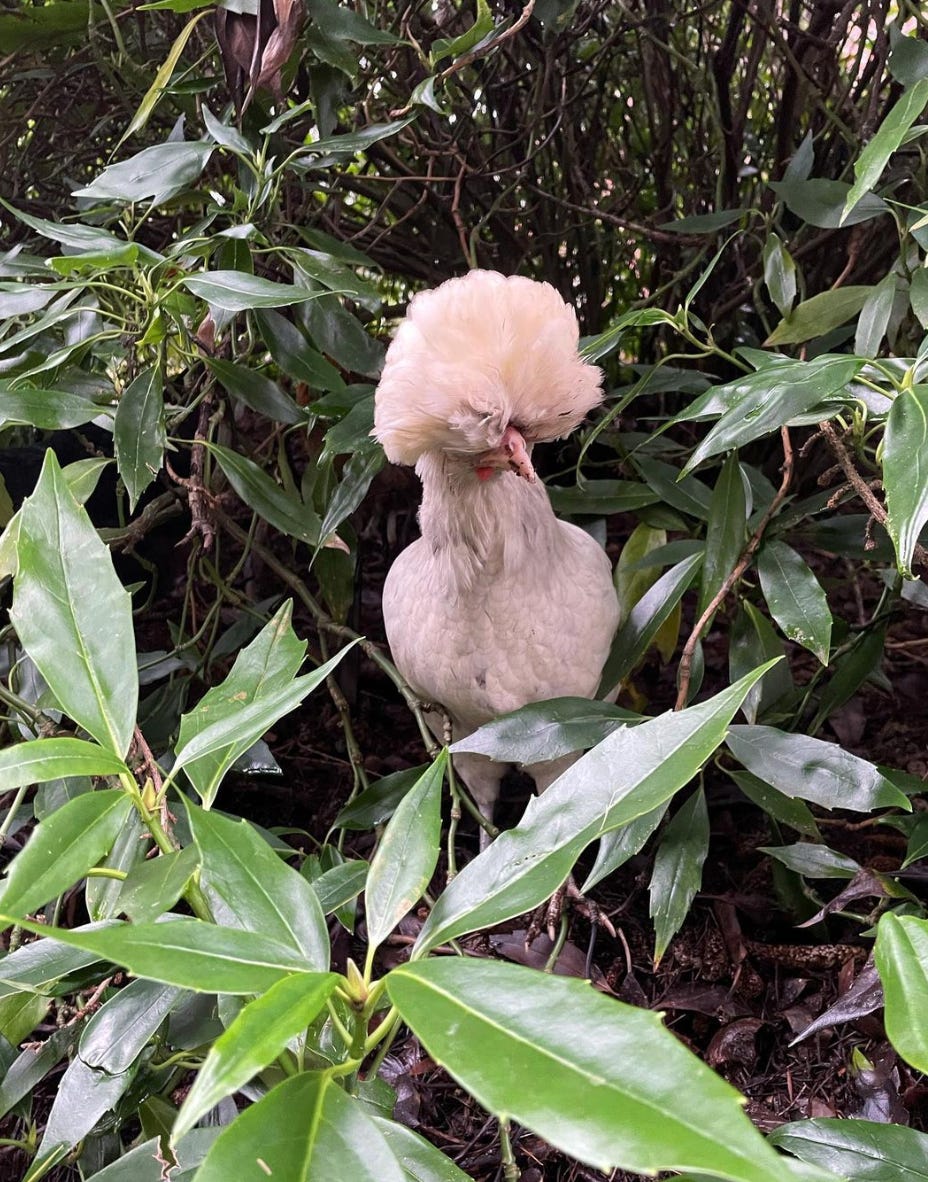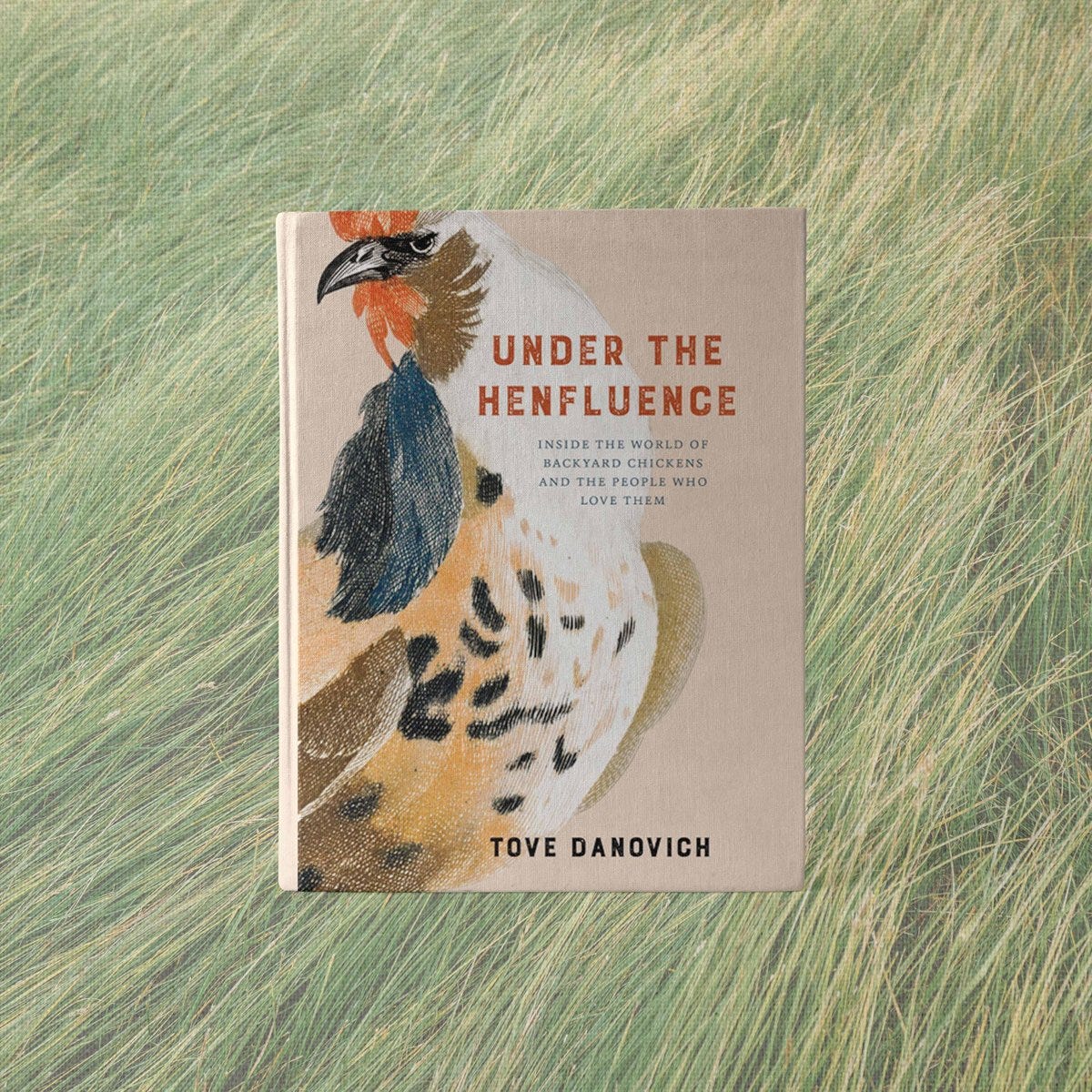How to Speak Chicken
The animals in my yard are always talking to each other
I often wish that I could hear English the way it sounds to non-native speakers. One of the pleasures of being decidedly un-fluent in the world’s languages is that I get to let the sound of them wash over me like songs. Usually I can hear the emotion in parts of a conversation (facial expressions help a lot here) even if I don’t know what they’re saying. After almost four and a half years spending hours a day with chickens, I can’t speak their language at all but I can feel it fluently.
First, I started recognizing their voices. I can hear from the house when Emmylou yelps because someone has pecked her. I know when a broody Peggy is taking a brief break from sitting on eggs in the nest because she announces it like a trumpet. Phryne has a voice that just sounds confused. Louise used to growl low in her throat after a crow’s shadow passed overhead. She was warning the other hens to be wary. Even if it wasn’t a hawk this time, that doesn’t mean it won’t be the next.
It's easy to get the hang of who sounds like what because one thing you’ll realize if you ever get chickens is that they constantly have something to say. Even when they were chicks they cheeped to each other quietly all day long. As both prey and flock animals, it’s important to check in and make sure everyone else is doing okay. They burble back and forth “Bup?” “Bup!” “Bup bup?” “Brrpt!” as they scratch worms out of the dirt. Chicken distress calls are distinct enough that there’s been early research into using the sound as a welfare indicator in large commercial flocks. It’s probably a direct result of this constant chatter that chickens are also always listening too.
Often a bird’s shadow swoops overhead and, even if the chickens stop to take note, they quickly return to what they were doing. I’ve heard red-tailed hawks cry while circling our house and watched with dismay as the hens decided that the dust bath they were in the middle of was more important than hiding immediately. What do they respond to? Other birds. Specifically, other birds doing an alarm call.
It's hard to explain what an alarm call sounds like exactly. They’re always loud and harsh. Usually the birds call over and over in short succession like someone yelling “Help! Help! Help!” and it doesn’t take long before other birds join in. Often birders note that the best way to find predatory birds like owls is by walking around the forest and listening for alarm calls. You might not be able to see that large bird camouflaged on a branch during the day but smaller birds flying around in the canopy will. I can recognize an alarm call now and the sound of it, the pure worry, hits me in the chest. Once, I could barely pick individual wild birds out of the wall of soundscape I referred to as “bird song”. Instead of multiple voices—the squeaky hinge of an Anna’s Hummingbird or the ringing rolls of a Northern Flicker—I only heard bird. It was like knowing enough to understand that someone was speaking French without being able to tell where one word stopped and the other began. I’m far from fluent but at least an advanced beginner now.
But the chickens, who have been bred and raised in domesticity for hundreds of years, knew exactly what these wild birds were saying. Chickens have different alarm calls for predators that come on the ground or from the sky and react differently to flock warnings for each. It’s not much of a surprise that they can understand each other but it’s impressive that they can understand the various calls of wild birds too. And wild birds know important words in the languages of other species. They respond appropriately when they hear another species of bird yelling warnings about snakes or hawks. Sometimes they even join in to try to mob away the predator.
It shouldn’t be surprising that they can communicate—even if you don’t speak French you probably know a few important survival words like “croissant” or “café au lait”—yet we speak so often of animals on a species level that it’s a bit of a shock to remember that they’re connected by more than just a food web. Birds use the information they get from one another to decide whether to approach and fight or run. Nature can be harsh but at least everyone isn’t completely on their own.
Just because they’re happy to live in coops alongside us, we act like chickens are hardly birds at all. Yet if given an opportunity to access the natural world, they’ll tune into it just as quickly as any other avian species. Learning to speak chicken in bits of sound and body language has been like Rosetta Stone for me into the world of wild birds. When we had baby screech owls in the yard, I could tell from their agitation when mom or dad was on their way with a snack. I even knew when they were about to make their first flight from the nest. Their bent knees and focused gaze reminded me exactly of the way the chickens psyched themselves up before making a big jump.
Before the flock, I was lost in sound. Now I hear the voices in the choir. It feels like a superpower to be able to know what birds are hiding in the bushes simply by the sound of them, to have a sense of whether all is calm—or not. I know when I hear a mob of crows or a sharp alarm call to look up. I just might see something wonderful and rare.
News from the Coop
If you follow me elsewhere, you might already know that my first book Under the Henfluence: Inside the World of Backyard Chickens and the People Who Love Them is available for preorder and will be released on March 28, 2023! Things are starting to wind up for the book including, most excitingly, cover reveals for the US and UK versions of the book. Both covers are absolutely gorgeous and I couldn’t be happier with them. A lot of people are preordering the book which is amazing! Preorders are huge for first-time authors and help tell bookstores that people are interested in a book exploring the world of chickens. A few people have told me they preordered a copy for their friends and relatives who have and love chickens! (I’ve gotten a lot of these gifts myself over the years and let me tell you, new chicken books are always welcome.)
If you’re in the US and would like to preorder a signed copy, you can get one from my local bookstore Powell’s Books. Otherwise you can order from a bookstore of your choice here or abroad!
Those who read all the way to the end get a special treat. This video of Emmylou running has somehow gotten 3.5 million views and maybe you’d like to watch it too!
If you need a chicken fix before the next newsletter, you can follow me on Twitter or Instagram.
If you liked this email, please share the newsletter with a chicken or animal lover in your life! As always, email me at underthehenfluence@gmail.com with any tips or comments. See you next month.



